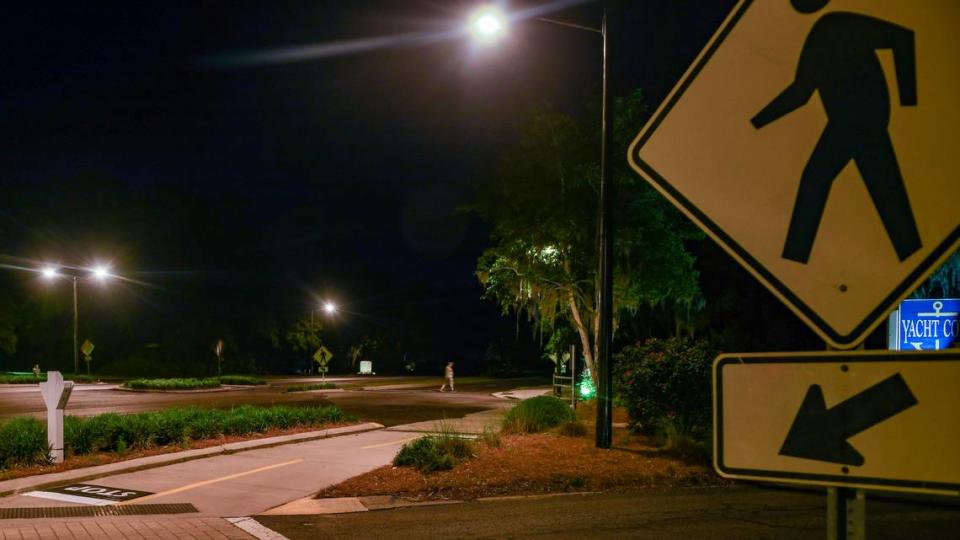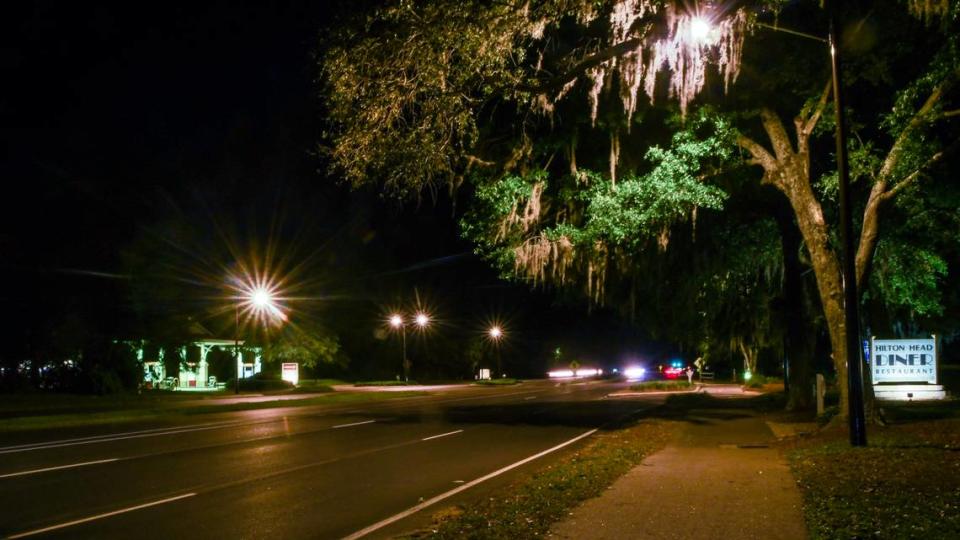Hilton Head’s dark roads and pedestrians are deadly combo. What the town is doing about it
Three overhead streetlights illuminate the intersection of Yacht Cove Drive and U.S. 278 on Hilton Head Island.
The lights are a rare sight along the roads of Hilton Head, which has long prided itself on avoiding light pollution and blending nature with construction.
Installed in 2020, they also act as an unofficial memorial to Charli Bobinchuck, an 11-year-old islander who was struck and killed while walking her dog across the intersection one night in June 2018.
The tragedy that took a child’s life spurred advocacy for safer streets and intersections on Hilton Head, including from Charli’s father, Bryan Bobinchuck. Still, much of the community remains opposed to overhead lights or flashing crosswalk signs they feel might affect local wildlife and diminish the natural preservation that drew them to Hilton Head.
Meanwhile, pedestrian and cyclist deaths on the island continue to occur, each incident reigniting discussions on pedestrian safety. Since Jan. 1, 2018, nine pedestrians or cyclists have been killed on Hilton Head, by the town’s count.
In January this year, Michigan native Steven Younce was struck and killed while crossing U.S. 278 near Matthews drive around 11 p.m.
Younce’s death sparked the lighting debate anew on social media. Hilton Head resident Mike Treschitta was one of several people who spoke out in favor of more pedestrian safety measures, commenting that it seemed town officials cared more about sea turtles than its residents and visitors.
“It was a little bit of frustration,” Treschitta, an eight-year island resident, told The Island Packet. “Obviously I don’t think the town cares more about turtles than people, but it’s frustration about, how many times is this going to happen until something gets changed? It seems like every single year, there’s people getting hit either walking or on their bike at night.”
When Treschitta first moved to Hilton Head, he said he accidentally drove into the wrong lane of traffic one of his first nights on the island due to the lack of visibility.
“Thank God nothing happened, but I could see how, with this being a tourist area with a lot of people new to the area, that could be an issue,” Treschitta said. “That’s how people get hurt. ... Obviously when somebody gets hit in the road, I think a little bit of it is people need to look where they’re going, but I think there’s some things the town can do to help alleviate the problem.”

Anielka de Manzanares, another Hilton Head resident, said she, her friends and family members have all had uncomfortably close calls with pedestrians trying to cross U.S. 278 after dark. While there is some responsibility to be placed on pedestrians paying attention to safely cross the road, Manzanares said, she also believes the town could provide more flashing pedestrian signals at crosswalks.
Off-island drivers who come to Hilton Head regularly have also expressed concern about driving conditions. Denise Gouldie, an Okatie resident since 2007, said she’s especially wary of going to the island during major events or peak tourist season.
“We were leaving the lantern festival last year and went to make a left turn out of the Coligny parking lot, and then almost got T-boned, then sideswiped on the other side, because people are all sorts of confused. There’s no light. There’s little to no navigation lights,” Gouldie said. “People just get on island time, and I think they get confused.”
How dangerous is roadway darkness?
Of the nine Hilton Head pedestrian and cyclist fatalities recorded by the town since 2018, five occurred after dark, accounting for sunset variation throughout the year.
The Bluffton area had six pedestrian and cyclist fatalities in the same timespan, according to State Department of Public Safety data dating back to Jan. 1, 2018. Five of those were near or after sundown. Beaufort and the outlying area reported 14 fatalities.
During an earlier period, from 2000 to 2016, previous Island Packet reporting showed 28 pedestrians and cyclists had died on the island, 20 of those deaths taking place after dark.


South Carolina as a whole ranked second in pedestrian deaths per capita in the National Highway Traffic Safety Administration’s 2020 report.
The nonprofit National Safety Council reports from NHTSA data that close to 74.5% of pedestrian fatalities occur at night. Of all 2021 fatalities, 39.1% took place at night in lighted areas and 35.38% at night on unlit streets.
At night, drivers on Hilton Head rely almost exclusively on their vehicle’s headlights to see.
Auto safety expert Byron Bloch said headlights tend to be one of the car parts most often overlooked for maintenance, and consequently, most drivers’ lights are underperforming.
Bloch has been serving as an expert witness in court cases since the 1950s, with most of the cases involving automobile failures or injuries related to car accidents.
“Some cars’ headlights have a cover over them made out of plastic, and over time the plastic sort of turns very whitish,” Bloch said. “That greatly blocks the illumination from the headlight going down the road ... that shows the indifference of some car companies that they knowingly put these poor plastic lens covers over the headlights, knowing that they’re going to deteriorate.”
Bloch emphasized drivers should check their headlights regularly and purchase headlight cover cleaning kits — usually available at auto parts stores or dealerships — to ensure their lights are maintained.
The issue is compounded by the lack of specific federal regulations or requirements for how far a vehicle’s headlights must shine. Most state driving manuals estimate high beam headlights let drivers see between 350 to 400 feet, while low beams illuminate 100 to 200 feet.
Posted speed limits range between 45 and 55 mph on much of the island’s stretch of 278. Drivers could travel farther than or near the edge of their low-beam illumination distance in about two seconds, assuming they’re driving at or under the island’s speed limits — though past data presented by insurance companies and trade magazines hints high percentages of drivers report regularly exceeding posted speed limits, especially on freeways.
Bloch said it can take between 2.5 to 8 seconds for a driver to recognize danger in the road, decide to brake or swerve, and then implement the decision. The margin of error is much tighter at night with deficient lights, he added.
Safety is also contingent on the condition of the vehicle’s breaks and the weather.
Old age can also impact vision and increase the time it takes for drivers or pedestrians to recognize danger and affect their nighttime vision, Bloch said, though younger, inexperienced drivers present their own risks.
Hilton Head’s median age is 57.9 years, according to data presented at Tuesday afternoon’s town budget hearing.
While the town has only around 40,000 permanent residents, last year it attracted 3.1 million visitors.
Town engineer Jeff Buckalew said Hilton Head’s high volume of pathway users, many of whom may not be from the area, can create a higher risk for pedestrians to be killed or injured.
More lights on the way?

The lights installed two years after Charli Bobinchuck’s death split the community, according to a town survey administered at the time of their installation.
The Island Packet previously reported around 57% of respondents to the town’s survey indicated they “dislike” or “dislike very much” the light installations. The survey hadn’t yet closed at that time.
“There were a lot more folks that disliked the lights than liked them,” Buckalew said. Roughly 200 residents responded to that survey.
While many residents have cited concerns for the island’s sea turtle nesting population as part of their opposition to installing more streetlights along U.S. 278, Sea Turtle Patrol Hilton Head Island’s Amber Kuehn said inland lights near the highway wouldn’t affect sea turtles.
“Hilton Head has very little light inland because of aesthetics, to keep it natural,” Kuehn said. “The beachfront ordinances that have to do with lighting and sea turtles only apply to lights that can be seen from the beach, so it’s not even on the road.”
Despite negative feedback regarding the Yacht Cove Drive lights, Buckalew said the town baked plans into a pair of capital improvement projects to introduce more pedestrian safety features, including lighting.
The two efforts listed on the town’s capital improvement projects dashboard will introduce lighting to areas of U.S. 278 near Northridge Drive and near Palmetto Parkway.
Buckalew said Matthews Drive, the site of Younce’s death earlier this year, is included in the scope.
Those projects are expected to move forward alongside another “corridors project,” Buckalew said.
“(The corridors project) is to help standardize the infrastructure along these major thoroughfares — William Hilton Parkway, Pope Avenue, Palmetto Bay Road,” Buckalew said. “We want to make sure the infrastructure amenities are consistent, so that’s everything from crosswalks, to pathways, to park benches, to trash cans, to signage.”
The larger corridors project could introduce more lighting than is already planned to be installed near the Northridge Drive area, but for now, the Northridge stretch remains the only place set to install more lighting.
“Out of that corridors program there will be guidance, or standardization, and if it determines that, ‘Hey, all the signalized intersections need to have overhead streetlights,’ then we’ll fund those, prioritize those and construct those,” Buckalew said.
Another safety feature, part of a new adaptive traffic management system, is mounting thermal imaging cameras at intersections with traffic lights. The cameras will detect cyclists and pedestrians waiting to cross and cycle the street lights accordingly.
“If everyone obeys the signs, hopefully everyone will stay safe,” Buckalew said.

